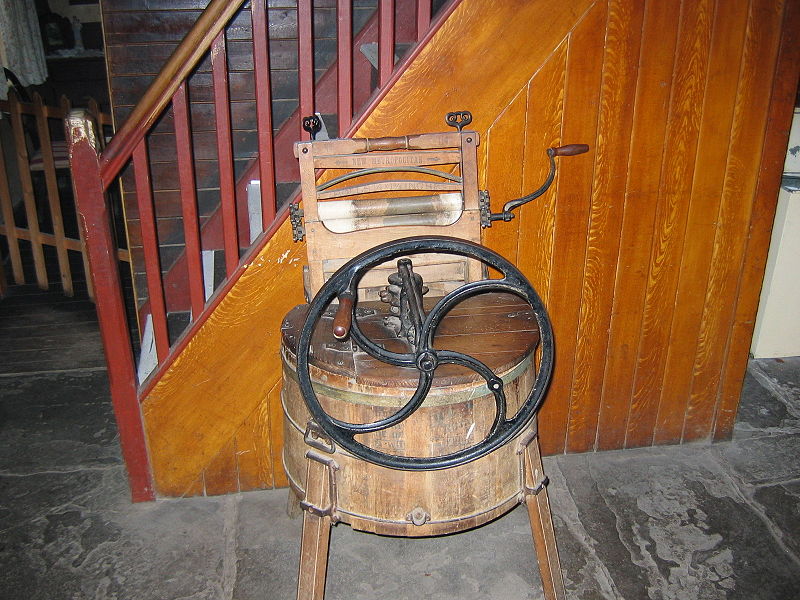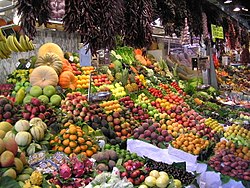Ask Happy Homemaker!
by compound complex 337 Replies latest jw friends
-
-
compound complex
Washing machine technology was developed as a way to reduce the drudgery of this scrubbing and rubbing process, by providing an open basin or sealed container with paddles or fingers to automatically agitate the clothing. The earliest machines were often hand-operated but were built with the belief that the machine itself was faster and easier to operate than washing the clothing by hand directly. As electricity was not commonly available until at least 1930, these early machines were often operated by a low-speed single-cylinder hit and miss gasoline engine.
Because water usually had to be heated on a fire for washing, the warm soapy water was precious and would be reused over and over, first to wash the least soiled clothing, then to wash progressively dirtier clothing. The load of soaking wet clothing would be removed, and another load of dirty clothes added to the machine. While the earliest machines were constructed entirely from wood, later machines made of metal permitted a fire to burn below the washtub, to keep the water warm throughout the day's washing.
Removal of soap and water from the clothing after washing was originally a separate process. The soaking wet clothing would be formed into a roll and twisted by hand to extract water. To help reduce this labour, the wringer/mangle was developed, which uses two rollers under spring tension to squeeze water out of the clothing. Each piece of clothing would be fed through the wringer separately. The first wringers were hand-operated, but were eventually included as a powered attachment above the washer tub. The wringer would be swung over the wash tub so that extracted wash water would fall back into the tub to be reused for the next wash load.
-
compound complex
Reposted for those yet to attend the DC; a friend informed me that NO announcement restricting use of paper towels was made at his convention site.
Dear Happy Homemaker,
This is a question about cleaning, but it's cleaning on a very large scale. I will be attending a Bible convention next month and have received a mandatory cleaning assignment. It's cleaning bathrooms at a giant stadium. My boss (a guy, I mean "brother") went over a ten-page list of dos and don'ts with me and a dozen or so other "volunteer" ladies. I am livid - me and my sisters are pxxxxd - because we must clean an entire bathroom with ONE PAPER TOWEL EACH! I don't want to question divinely-appointed authority and fail to show sisterly submission, but this is like making bricks without straw. You do know the story, don't you, about the children of God in Egypt, the typical representation of God's modern-day enemy ...
Dear Sister,
Don't preach to me. Your problems go far deeper than the triviality of cleaning 12 sinks, 8 johns and 3 three-by-six mirrors with one stinking paper towel. Been there, done that. But I'm certainly not going to take you to task over your fixation with an Old Testament religion. It's a question of faith. If you are cursed with damnable little faith, then sneak in your own roll of paper towels. If questioned, simply say in a tiny and humble voice that it's a small but meaningful donation to the Lord's work ...
You don't say "Lord," though, do you?
PS - and don't let them give you that line that you're rushing ahead of G....
Feel better now? I hope so!
Happy Homemaker!
-
compound complex
A paper towel is a towel made from paper. It serves the same general purposes as conventional towels, such as drying hands, wiping windows, dusting, and cleaning up spills. Because paper towels are disposable, they are often chosen to avoid the contamination of germs. [1]
Contents
[ hide ][edit] Invention
In 1879, a school teacher in Philadelphia gave students individual paper squares, so that the single towel in the bathroom would not be infected with germs. [2] When Arthur Scott, head of the Scott Paper Company, heard about it he decided to try and sell a load of paper that had been made too thick to use as toilet paper. [3] After learning about a teacher who had cut pieces of soft paper for her student to use to wipe his nose, he cut the paper into small sheets and sold them as disposable towels. [4] Later, he renamed them as Sani-Towel. In 1931, he first introduced the paper towel for the kitchen and created a whole new grocery category.
[edit] Manufacture
Paper towels are made from wood [1] or recycled paper. They are sometimes bleached during the production process to make the color whiter. [5] It is not uncommon for rolls of paper towels to include intricate colored images on each square (such as flowers or teddy bears). Resin is often added to strengthen the product. [1] Patterns of shapes such as circles or diamonds are often imprinted into the paper towels to help it hold moisture. [5] Most rolls are manufactured with two layers of thin paper, but different types can have more or fewer layers. Generally the more layers they have, the stronger they are, and the less likely they are to rip.
-
compound complex
Dear Happy Homemaker,
My bottoms are so old and sagging but I can't afford new ones. This is about my four cane chairs. The cane is in otherwise good repair. Is there a solution that costs next to nothing?
I appreciate your help.
Chaz Chaise
Dear Chaz,
Yes, yes! There is a solution and it's one quart hot water plus 1/2 cup baking soda. Simply soak two cloths in this cheap and effective solution and set one drenched rag upon the surface of the cane while saturating the underside with the other. Mop up excess dampness with dry toweling. Place your four chairs in brilliant sunshine and watch your bottoms tighten up!
Hope this helps!
Happy Homemaker!
-
compound complex
Produce
From Wikipedia, the free encyclopedia
Jump to: navigation, searchProduce on display at La Boqueria market in Barcelona, Spain.
Produce is a generalized term for a group of farm-produced goods, generally limited to fruits and vegetables. More specifically, the term "produce" often implies that the foods are fresh and generally in the same state as where they were harvested. In supermarkets the term is also used to refer to the section where fruits and vegetables are kept. Produce is the main product sold by greengrocers, farmers' markets, and fruit markets.
In some parts of the world, including the United States, produce is marked with small stickers bearing Price Look-Up codes. These four or five digit codes are a standardized system intended to aid checkout and inventory control in produce markets.
[edit] Seasonal Produce
Although in the United States most produce is available year-round, produce is at its best and cheapest in the season it is harvested. Seasonality of produce depends on the region. Below is a general list of seasonality for United States produce.
Spring fruits are apricots, pineapple, strawberries, and mango. Spring vegetables for spring are peas (sugar snap and snow) and more delicate cabbages including mustard greens, baby lettuce, baby spinach and watercress. Also in season are artichoke, asparagus, avocado, new potatoes, rhubarb.
Summer fruits include some berries (blackberries, blueberries, raspberries) and stone fruit (nectarines, peaches, and plums) as well as melons. Summer vegetables include beets, corn, cucumber, eggplant, green beans, tomatoes, zucchini.
Autumn fruits includes apples, grapes, figs, pears, and pomegranates. Autumn vegetables include many cultivars of wild cabbage (broccoli, Brussels sprouts, cauliflower, collards, endives, and kale). Root vegetables (garlic, ginger, parsnips, turnips and yams) and winter squash (acorn squash, butternut squash and pumpkins) are also in season. Corn is in season and peas, seasonal in spring, are also seasonal in late autumn.
Winter fruits include citrus (clementines, grapefruit, oranges, and lemons) and pomegranates. Winter vegetables include hardier cabbages (kale, leeks, raddicchio, and Brussels sprout). Also seasonal in winter are some root vegetables (rutabaga, turnips, and radishes) as well as winter squash.
Some produce, such as onions, lettuce and spinach, are seasonal year-round.
Retrieved from "http://en.wikipedia.org/wiki/Produce" Categories: Food and drink
-
compound complex
Dear Happy Homemaker,
I've decided to do some long-overdue deep-cleaning but want to make it easy and not spend forever doing it. For example, I have all sorts of hobby paraphernalia in a large chest of drawers. Likewise, my kitchen and bathroom cabinets and drawers need to be tidied.
When vacuuming with my tank vacuum cleaner, however, all the little stuff gets sucked up with the dust. What's a sucker to do?
Thanks.
Dusty
Dear Dusty,
Apply a piece of cheesecloth of sufficient size to cleaner nozzle with a band of rubber. Up sucks the dust while valuables rest in place. Chunks of debris that catch in screening can be removed by hand and discarded.
For future ease of drawer and cabinet maintenance, service storage areas with shallow boxes, box lids or any such container (rectangular is best) and arrange in geometrically functional patterns. Place your items therein. When the time comes again to clean and dust, simply remove containers and wipe interior surfaces with dampish cloth.
What a time-saver!
Hope this helps!
Happy Homemaker!
-
compound complex
http://www.youtube.com/watch?v=B3CuK2emZhA
My personal fave ...
-
compound complex
Post Script for Ute:
The four push pins holding string box in place should be removed with string ... the pins marking where picture-hanging hardware eventually go remain in place.
If you wish the lowest frames in the ensemble to have their bottom molding align with lower horizontal string-guide, you use the same technique for locating your upper frames: pull hanging wire taut toward upper molding BUT measure distance from apex of wire to LOWER molding. At that distance from the lower line you set your pin.
A nice touch for your gallery would be track lighting.
H.H.
-
calico
Dear Happy Homemaker:
I have an ugly kitchen kitchen floor and a cheap husband--what can I do? (or was it an ugly husband and a cheap floor?)

